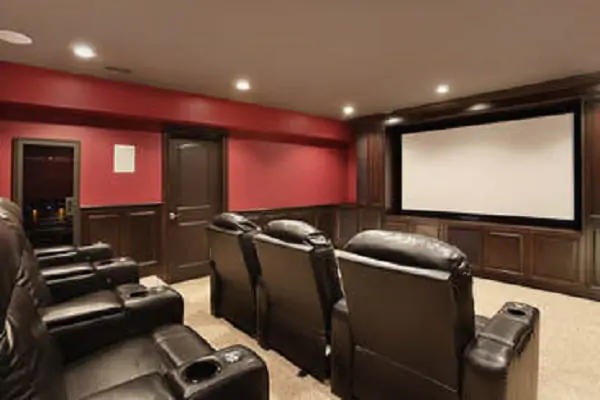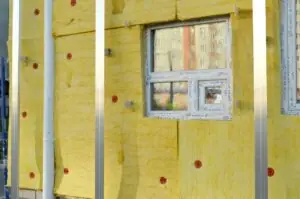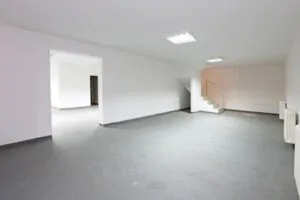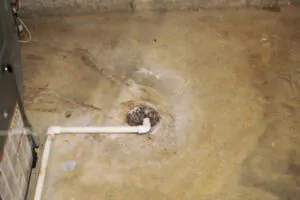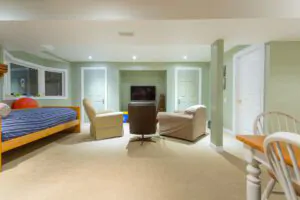Turning your basement into a home theater can transform movie nights into an epic experience. Basements, with their natural darkness, create the perfect setting for film watching because less sunlight means better screen visibility.
Keeping sound in is key, so using things like noise-canceling panels ensures that your action-packed movies don’t become a neighborhood event. Seating matters too—everyone wants a comfy spot! From plush recliners to casual bean bag seats, choices abound based on how big the space is and what feels best.
Designs can range from a 1920s French art deco vibe to something more modern that speaks directly to movie buffs. These spaces not only look cool but also add value by making your home the go-to place for entertainment.
Budgeting smartly means you won’t break the bank while building this dream space; costs vary but planning keeps surprises at bay.
Don’t forget about tech and decor! Choosing screens that fit your room size and utilizing convertible seating for low ceilings make all the difference. Moreover, creative touches like adding a minibar or designing the area for both games and movies uplevel the fun factor significantly.
With advice available online from expert designs to DIY tips based on professional standards, creating an amazing basement home theater has never been easier or more accessible. This guide aims to inspire and equip you with everything needed to start this exciting project right away.
Key Takeaways
- Transforming your basement allows you to install multiple seating options like couches and cinema-style seats for an immersive movie experience. With proper planning, even large basements can have rows of comfortable seating ensuring everyone gets a great view.
- Basements naturally offer the perfect darkness for home theaters, making movies clearer without glare from windows. Adding thick curtains can further reduce any light coming in, enhancing your viewing pleasure anytime.
- Soundproofing your basement not only improves sound quality inside but also prevents noise from leaking out and disturbing others. Techniques like using sound barrier mats under carpets or constructing isolated rooms within the space are effective.
- Creative designs such as bars or brewery setups alongside a big screen can turn the area into a multifunctional entertainment space where friends and family gather to enjoy more than just movies.
- Working with a designer can bring many benefits by optimizing the layout for both visual and audio enjoyment while selecting cozy furniture that enhances the movie-watching experience.
Benefits of Having a Basement Home Theater
Transforming your basement into a movie palace brings the magic of cinemas right to your doorstep. Enjoy films in the best setting without leaving home, thanks to spacious seating and perfect darkness that make every viewing a premiere event.
Spacious design for multiple seating options
Basements often provide the perfect canvas for a home theater due to their large open spaces. This allows homeowners to set up multiple seating options, ranging from cozy couches for family movie nights to cinema-style stadium seating that mimics real movie theaters.
With the right layout, even larger basements can host rows of big armchairs, ensuring every guest has the best seat in the house. The key is to plan according to your room’s dimensions and preferred seating arrangements, creating a space where everyone feels part of the action.
Choosing various seating types not only maximizes comfort but also enhances viewing experiences. Install high-end surround sound systems along with soundproofed walls to make it feel like you’re in the heart of cinemas without leaving your basement home theater.
For an added touch of luxury, consider adding cabinets stocked with snacks and a mini bar or brewery setup nearby, so refreshments are always within reach. This design flexibility makes basements an ideal location for those looking forward to customizing their entertainment spaces without constraints.
Natural darkness for optimal viewing
The natural darkness of basements creates an ideal setting for home theaters. This unique feature eliminates the glare and reflections often seen in rooms with abundant natural light.
Such conditions are particularly beneficial for enjoying movies as they were intended in a cinema-like environment, where every detail on the screen is crisp and clear.
In my own experience, transforming a basement into an entertainment space significantly improved our movie-watching sessions. The earth surrounding three or four sides of most basements helps maintain this darkness, making it easier to control ambient light levels.
We found that installing thick curtains over any small windows further reduced light intrusion, enhancing the IMAX-like experience at home without the need for expensive lighting controls.
This advantage also means less energy is spent on trying to block out unwanted sunlight during daytime viewings, allowing for spontaneous movie marathons any time of day. With proper soundproofing techniques applied, not only does this setup provide optimal visual quality but also immersive audio that makes you feel like part of the action—without disturbing anyone upstairs or next door.
Easily customizable for unique designs
Your basement’s structure, with its concrete floors, serves as a blank canvas for your home theater. This solid foundation not only keeps vibrations low for better sound quality but also supports unique design features.
You have the freedom to tailor every aspect of your space. From selecting thematic décor that reflects your favorite movie genres to installing advanced audio systems that immerse you in cinematic soundscapes, personalization possibilities are endless.
Drawing from personal experience in designing my own basement theater, incorporating elements like adjustable lighting systems and modular furniture can transform the area into a multipurpose entertainment hub.
I chose LED strip lights for customizable ambiance and sectional sofas that could be rearranged based on the number of guests or type of event. This flexibility ensured that my theater was not just for watching movies but served as a gathering place for game nights and sports events too.
Elements to Consider in Basement Home Theater Design
Crafting the perfect basement home theater requires attention to several crucial factors. Sound quality and soundproofing materials make sure your movie experience is immersive without disturbing others outside the room.
The amount of ambient light can affect how well you see the screen, so plan for ways to control it with special window coverings or lighting systems. When choosing seating options, consider comfort and view angles for everyone.
Working with a professional interior designer might help tailor the space to your tastes while also considering multifunctional uses beyond just watching films or TV shows.
Sound quality and soundproofing
Improving sound quality and installing soundproofing are key steps in creating an ideal basement home theater. Placing a sound barrier mat under the carpet significantly reduces noise, keeping the movie’s audio inside your designed space while blocking external sounds.
This method not only enhances your viewing experience but also prevents disturbances to others in the house.
Constructing a room within a room is another effective strategy I have personally found successful. It involves careful building methods that isolate the theater area from the rest of the basement, ensuring that sound doesn’t escape.
These construction techniques can make all the difference in keeping dialogue clear and effects impactful without turning your entire home into an echo chamber.
Amount of ambient light
Controlling the amount of ambient illumination in your basement home theater is crucial for creating the perfect viewing experience. Too much natural light can wash out images, making it hard to see details on the screen.
To tackle this issue, you might use thick curtains or shades that block out external light completely. This ensures movies and games look their best at any time of day.
Designing a lighting scheme involves more than just blocking unwanted light; it also includes adding the right kind of artificial lights to enhance your theater’s ambiance. Decorative wall-mounted lamps, often with dimming options, allow for flexibility depending on what you’re watching or doing in the room.
These fixtures provide enough light to navigate without interfering with screen visibility. For an even more controlled environment, planning where your television or projector will go reduces glare and maintains optimal picture quality.
Offering various lighting choices like sconces gives personality to your space while serving a functional purpose. Each choice impacts how much ambient brightness affects your viewing area—a key factor to consider during design stages for anyone looking to update their entertainment zone in the basement.
Seating options
Choosing the right seats for your basement home theater transforms how you enjoy movies or games. You can pick from recliners, bean bag chairs, and sofas. Each option offers different levels of comfort and style.
For example, recliners give individual seating that’s perfect for long movie marathons, while bean bags allow more flexibility, ideal for kids’ areas or casual spaces. Sofas bring everyone together, making them great for family movie nights.
I found that measuring the room first helped me decide on the best layout. This ensured everyone had a good view without cramming furniture too close to the screen or each other. Placing seats in rows with enough space to walk between made our basement feel like a real theater.
Plus, adding some small tables for snacks and drinks made movie nights better than going out!
Working with a designer
Hiring a designer for your basement home theater brings many benefits. They have the experience to define the space, making sure it fits all your needs. A designer knows how to pick the best gear for both sound and viewing quality.
They also understand the importance of soundproofing, so you don’t bother others in the house or neighbors.
A good designer will select cozy chairs and couches that make watching movies a better experience. They know about finishing touches too, like decor and lighting that improve movie watching.
With their help on layout and design tech aspects, your basement can turn into an amazing entertainment area.
Other uses for the space
Turning your basement into a home theater opens the door for more creative spaces. Think about adding a workout area in one corner. This way, you get to enjoy movies and keep fit without leaving the house.
A small section can also become an art studio where kids and adults unleash their creativity.
For those who love hosting, consider setting up a guest room alongside the entertainment space. It ensures visitors have their cozy spot while staying over. Another idea is creating a study or home office area, perfect for work or homework sessions away from household distractions.
Lastly, integrating smart technology enhances convenience and security within these multifunctional spaces. Use intelligent lighting systems to switch moods between cinema nights and study time with just one click on your phone or tablet.
Secure entrances with smart locks give peace of mind when converting part of the basement into living quarters for guests or family members needing privacy.
Creative Basement Home Theater Ideas
Get ready to transform your basement into an entertainment paradise. These designs will inspire you to create a space where movies come to life.
Bar or brewery setup
Turning your basement into a bar or brewery brings a unique flair to home entertainment. I found that adding a sleek, shiny brewery setup, complete with all the brewing gadgets like fermenters and chrome draft towers, transformed my space.
It’s not just about making beer; it’s about creating an area where friends can gather and enjoy home-crafted beverages while catching a movie or chilling out. Planning this space took time, focusing on layout and functionality to ensure everything from the brewing process to serving drinks ran smoothly.
Building an electric brewery proved quite feasible and didn’t break the bank. The key was designing a dedicated brew room that fits seamlessly with the rest of my entertainment area.
This approach allowed for producing various beer types without sacrificing style or comfort in my home theater setting. Whether sharing with family or hosting friends, this multifunctional space has upped the ante on basement fun, offering something far beyond traditional setups.
Multi-purpose game and movie room
Transforming your basement into a multi-purpose game and movie room offers endless entertainment possibilities. Installing a big screen for movies, alongside areas for pool, board games, and darts creates a dynamic space where family and friends can gather.
I found that making small adjustments to accommodate both viewing and playing areas makes the room more functional without sacrificing comfort or style. For instance, using convertible furniture ensures there’s plenty of seating for movie nights while also freeing up space when it’s game time.
To achieve this balance, it’s crucial to consider the layout. Some basements may have odd shapes or support pillars that challenge traditional designs. Yet, these unique features often lend themselves to creative solutions like custom-built storage units that double as seatings or acoustic panels that enhance sound quality for both films and music listening sessions.
This approach turns potential obstacles into integral parts of your multipurpose room’s charm.
Cuddle couch for cozy viewing
A cuddle couch turns a simple movie night into a cozy, intimate experience. Instead of stiff, separate seating, this sofa lets guests snuggle close together or sprawl out comfortably.
It’s especially great for basements designed as home theaters. With its plush cushions and generous space, everyone finds their perfect spot to relax and enjoy the show.
Integrating a cuddle couch into your basement entertainment area brings more than just comfort; it adds a “cuddle factor” that traditional movie theater seats lack. Families love the flexibility it offers, from gathering close on family movie nights to providing an extra sleeping spot during sleepovers.
Its versatility makes it an essential piece for anyone aiming to create a welcoming and comfortable viewing environment in their home.
Choosing a cuddle chair or sofa also allows for better use of space in smaller rooms where conventional seating might feel too cramped or restrictive. These pieces encourage relaxation and make every film viewing something special without sacrificing style or comfort.
TV wall setup
Creating a TV wall setup in your basement home theater brings the big screen experience right into your home. First, choose a spot on your wall that allows everyone to see the display without straining their necks.
This might mean mounting the television above a fireplace or on a main wall where chairs and couches can face directly towards it. Use mounts that let you adjust the angle of the screen for optimal viewing comfort.
Next, think about wiring and components. Hidden wires make everything look neat and professional. Consider hiring an expert to run cables through the walls for power, HDMI connections, and internet access if needed.
They can also help set up additional gadgets like streaming devices, sound systems, or game consoles which enhance your movie-watching experience. Lastly, adding lighting around your TV can reduce glare and improve visibility during those daytime movie marathons.
Cinephile inspired design
A cinephile inspired design takes your basement home theater from plain to striking. This idea lets you blend personal taste with cinematic passion, creating a space that’s both functional and visually appealing.
Imagine walls adorned with posters from classic films or shelves filled with vintage film reels and director’s books. Install lighting that mimics the soft glow of a theater aisle, adding to the authenticity and atmosphere.
Use 1920s French art deco designs for elegance and style. This approach adds unique flair, making your entertainment space stand out. Such details not only pay tribute to the golden age of cinema but also provide a sophisticated backdrop for movie nights at home.
Consider comfortable seating styled after old Hollywood movie palaces to complete the experience, ensuring every screening feels like an event.
Tips for Planning and Building Your Basement Home Theater
Crafting the perfect basement home theater requires thoughtful planning and careful building. Starting with a clear budget helps manage expenses for audio systems and remodeling work.
Choosing the ideal screen size transforms viewing into an unforgettable experience. Comfortable seating arrangements make movie nights more enjoyable. Soundproofing walls ensures that epic movie soundtracks don’t disturb the rest of your house.
Scouring online sales can lead to great deals on projectors and speakers, stretching your budget further.
Budgeting for equipment and construction
Budgeting plays a crucial role in setting up your basement home theater. It’s essential to know that costs can range anywhere from $3,000 to $15,000. This wide range depends on the type of gear and construction work you need.
Finding equipment that offers great performance without breaking the bank is key. You’ll want to look for sales on projectors, sound systems, and comfy seating options without compromising quality.
Start planning your budget by listing all necessary items and their estimated costs. Include high-quality audio systems, projectors with crisp images, and comfortable furniture in your list.
Don’t forget to account for labor charges if you’re hiring professionals for installation or construction tasks. From my own journey in creating a home theater space, I learned the importance of allocating extra funds for unexpected expenses that might arise during construction phases.
Selecting affordable yet durable materials for construction will also help keep costs down while ensuring your basement theater stands the test of time. My tip? Shop around online deals between September and December when prices tend to drop significantly – this strategy saved me hundreds!
Choosing the right size movie screen
Picking the perfect size for your movie screen in a basement home theater is crucial. You need to measure how far your couch or chairs will be from the screen. This distance guides you on how big the screen should be.
The general rule is that the diagonal length of the screen should match or exceed how many feet away you plan to sit. For example, if you decide to sit 10 feet away, aim for a screen that’s at least 10 feet diagonally across.
In my own basement transformation, I learned this lesson firsthand. Initially, I chose a screen too small for my space and ended up squinting during action scenes or missing subtle details in darker films.
After swapping to a larger display based on sitting distance, movies became an immersive experience rather than just watching TV in another room. Always use a tape measurer and calculate twice before buying your setup.
Consider also consulting with professionals who specialize in home entertainment setups if uncertainties arise. They bring invaluable advice tailored specifically to varied spaces, ensuring every movie night feels like stepping into another world right at home.
Utilizing low ceilings with convertible sofas
Low ceilings in a basement shouldn’t stop you from creating a comfortable home theater. Convertible sofas prove to be the perfect solution for this challenge. They can adjust to fit under low beams, making sure everyone has a great view of the screen without feeling cramped.
I once helped set up a friend’s basement with these sofas, and it transformed the space completely. We chose models that could easily switch between seating and lounging positions, maximizing comfort for movie nights.
Additionally, think beyond traditional seating arrangements by including bean bags or floor cushions. These options sit lower to the ground and work wonders in areas where headroom is limited.
During another project, we mixed convertible sofas with large bean bags, offering both style and versatility. This approach allowed us to create an inviting theater experience that guests loved because they could choose how they wanted to relax during films.
Incorporating proper soundproofing
Installing the right soundproofing materials can make a huge difference in your basement home theater. High-density insulation and special panels absorb echoes, making sounds clearer inside while keeping noise from escaping.
This method ensures that loud movie nights don’t disturb anyone not watching with you. My own experience showed me how effective denser materials like mass-loaded vinyl can be for walls and ceilings.
These upgrades transformed my noisy space into a snug movie haven.
Choosing the best acoustic adjustments involves more than just picking out panels; it’s about layering different types of sound-blocking techniques. Thick carpets and curtains add another level of sound control, softening any hard surfaces that bounce audio around the room.
Foam tiles or fabric-wrapped fiberglass panels double up as decor while dampening unwanted noise, creating an immersive cinema experience at home without bothering neighbors or other family members upstairs.
Checking out online deals
Scouring the internet for deals can lead to significant savings on your basement home theater project. Websites like HGTV provide a treasure trove of tips, ideas, and expert advice for those looking to build their own entertainment space.
This means you could discover ways to cut costs without cutting corners on quality. From finding discounted seating options to affordable soundproofing materials, online deals make it easier to stick within your budget.
Exploring online self-paced design schools based on CEDIA training offers another avenue to save. These educational platforms teach enthusiasts how to create a dedicated movie-watching room from scratch or upgrade an existing space with professional know-how.
Coupled with design plans inspired by diverse eras, such as the 1920s French art deco, these resources help in crafting a unique yet cost-effective home theater.
In addition, comprehensive guides available online walk beginners through every step of designing a home theater room. They cover everything needed from selecting the right size screen to understanding how low ceilings can influence furniture choices like convertible sofas.
Armed with this knowledge and attentive deal hunting, transforming your basement into an impressive cinema-like experience becomes not only achievable but also affordable.
Conclusion
Transforming a basement into a captivating home theater brings movies and games to life right in your own home. With the right design, soundproof walls, and cozy seats, any basement can become the go-to spot for entertainment.
Think of adding a bar or turning it into a multi-use space for even more fun. Every choice reflects your style and ensures memorable moments with family and friends. Create the ultimate entertainment space that stands out by focusing on what matters most: quality, comfort, and personal touch.
FAQs
1. What is the first step in creating a basement home theater?
The first step is to measure your space to determine the size of the screen and seating arrangement that will fit.
2. Can I use any type of lighting for my basement home theater?
Choose dimmable LED lights or soft wall sconces to create an ideal viewing atmosphere without glare on the screen.
3. Do I need professional help to set up my basement home theater system?
While you can set up a basic system yourself, hiring a professional can ensure optimal sound and picture quality.
4. How important is soundproofing for a basement home theater?
Soundproofing is crucial to prevent noise from escaping the room and to enhance your audio experience without disturbances.
5. Can I incorporate a snack area in my basement home theater design?
Yes, adding a small snack bar or concession stand enhances the movie experience and convenience for guests and family members.

